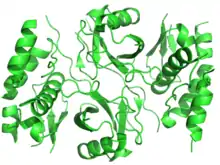Viral infectivity factor
Viral infectivity factor, or Vif, is an accessory protein found in HIV and other lentiviruses. Its role is to disrupt the antiviral activity of the human enzyme APOBEC (specifically APOBEC3G, "A3G" in short) by targeting it for ubiquitination and cellular degradation. APOBEC is a cytidine deaminase enzyme that mutates viral nucleic acids.
| Viral infectivity factor | |||||||||
|---|---|---|---|---|---|---|---|---|---|
 | |||||||||
| Identifiers | |||||||||
| Symbol | Vif | ||||||||
| Pfam | PF00559 | ||||||||
| InterPro | IPR000475 | ||||||||
| |||||||||
Vif is a 23-kilodalton protein that is essential for viral replication. Vif inhibits the cellular protein, APOBEC3G, from entering the virion during budding from a host cell by targeting it for proteasomal degradation. Vif binds to A3G as well as the cellular Cullin5 E3 Ubiquitin Ligase (ELOB-ELOC-CUL5) and a CBFB cofactor so that the ligase can be hijacked to tag A3G for degradation.[2] The crystal Structure of the HIV Vif BC-box in Complex with Human Elongin B and Elongin C was solved in 2008,[1] and the structure of the full Vif/E3 complex was solved in 2014.[3] In the absence of Vif, APOBEC3G causes hypermutation of the viral genome, rendering it dead-on-arrival at the next host cell. APOBEC3G is thus a host defence to retroviral infection which HIV-1 has overcome by the acquisition of Vif. Targeting Vif has been suggested as a strategy for future HIV drug therapies.[4]
Vif was considered as a phosphoprotein and phosphorylation seemed to be required for viral infectivity.[5][6] But recent studies with the use of metabolic labelling demonstrated that serine/threonine phosphorylation of Vif and A3G is not required for the interaction of Vif with A3G for Vif dependent degradation of A3G and the antiviral activity of A3G.[7]
In other species
Vif has been found in other Lentiviruses, including the Simian immunodeficiency virus (SIV), Feline immunodeficiency virus (FIV; Pfam PF05851), Visna virus (MVV) and Caprine arthritis encephalitis virus (Pfam PF07401).[8][9] The mamallian APOBEC3 enzymes are in an arms race with Vifs found in those viruses, actively evolving and diversifying to escape inactivation. Some Vifs use CYPA instead of CBFB.[10][11][12]
References
- Stanley BJ, Ehrlich ES, Short L, Yu Y, Xiao Z, Yu XF, Xiong Y (September 2008). "Structural insight into the human immunodeficiency virus Vif SOCS box and its role in human E3 ubiquitin ligase assembly". Journal of Virology. 82 (17): 8656–63. doi:10.1128/JVI.00767-08. PMC 2519636. PMID 18562529.
- da Costa KS, Leal E, dos Santos AM, Lima e Lima AH, Alves CN, Lameira J (2014-02-26). Kurgan L (ed.). "Structural analysis of viral infectivity factor of HIV type 1 and its interaction with A3G, EloC and EloB". PLOS ONE. 9 (2): e89116. Bibcode:2014PLoSO...989116D. doi:10.1371/journal.pone.0089116. PMC 3935857. PMID 24586532.
- Guo Y, Dong L, Qiu X, Wang Y, Zhang B, Liu H, Yu Y, Zang Y, Yang M, Huang Z (January 2014). "Structural basis for hijacking CBF-β and CUL5 E3 ligase complex by HIV-1 Vif". Nature. 505 (7482): 229–33. Bibcode:2014Natur.505..229G. doi:10.1038/nature12884. PMID 24402281.
- Miller JH, Presnyak V, Smith HC (November 2007). "The dimerization domain of HIV-1 viral infectivity factor Vif is required to block virion incorporation of APOBEC3G". Retrovirology. 4 (1): 81. doi:10.1186/1742-4690-4-81. PMC 2222665. PMID 18036235.
- Yang X, Gabuzda D (November 1998). "Mitogen-activated protein kinase phosphorylates and regulates the HIV-1 Vif protein". The Journal of Biological Chemistry. 273 (45): 29879–87. doi:10.1074/jbc.273.45.29879. PMID 9792705.
- Yang X, Goncalves J, Gabuzda D (April 1996). "Phosphorylation of Vif and its role in HIV-1 replication". The Journal of Biological Chemistry. 271 (17): 10121–9. doi:10.1074/jbc.271.17.10121. PMID 8626571.
- Kopietz F, Jaguva Vasudevan AA, Krämer M, Muckenfuss H, Sanzenbacher R, Cichutek K, Flory E, Münk C (November 2012). "Interaction of human immunodeficiency virus type 1 Vif with APOBEC3G is not dependent on serine/threonine phosphorylation status". The Journal of General Virology. 93 (Pt 11): 2425–30. doi:10.1099/vir.0.043273-0. PMID 22894923.
- Zhao Z, Li Z, Huan C, Wang H, Su X, Zhang W (2019). "CAEV Vif Hijacks ElonginB/C, CYPA and Cullin5 to Assemble the E3 Ubiquitin Ligase Complex Stepwise to Degrade oaA3Z2-Z3". Frontiers in Microbiology. 10: 565. doi:10.3389/fmicb.2019.00565. PMC 6434172. PMID 30941116.
- Gabuzda DH, Lawrence K, Langhoff E, Terwilliger E, Dorfman T, Haseltine WA, Sodroski J (November 1992). "Role of vif in replication of human immunodeficiency virus type 1 in CD4+ T lymphocytes". Journal of Virology. 66 (11): 6489–95. PMC 240141. PMID 1357189.
- Nakano Y, Aso H, Soper A, Yamada E, Moriwaki M, Juarez-Fernandez G, Koyanagi Y, Sato K (May 2017). "A conflict of interest: the evolutionary arms race between mammalian APOBEC3 and lentiviral Vif". Retrovirology. 14 (1): 31. doi:10.1186/s12977-017-0355-4. PMC 5422959. PMID 28482907.
- Konno Y, Nagaoka S, Kimura I, Yamamoto K, Kagawa Y, Kumata R, et al. (April 2018). "New World feline APOBEC3 potently controls inter-genus lentiviral transmission". Retrovirology. 15 (1): 31. doi:10.1186/s12977-018-0414-5. PMID 29636069.
- Yoshikawa R, Izumi T, Yamada E, Nakano Y, Misawa N, Ren F, et al. (January 2016). "A Naturally Occurring Domestic Cat APOBEC3 Variant Confers Resistance to Feline Immunodeficiency Virus Infection". Journal of Virology. 90 (1): 474–85. doi:10.1128/JVI.02612-15. PMID 26491161.
External links
- vif+Protein at the US National Library of Medicine Medical Subject Headings (MeSH)